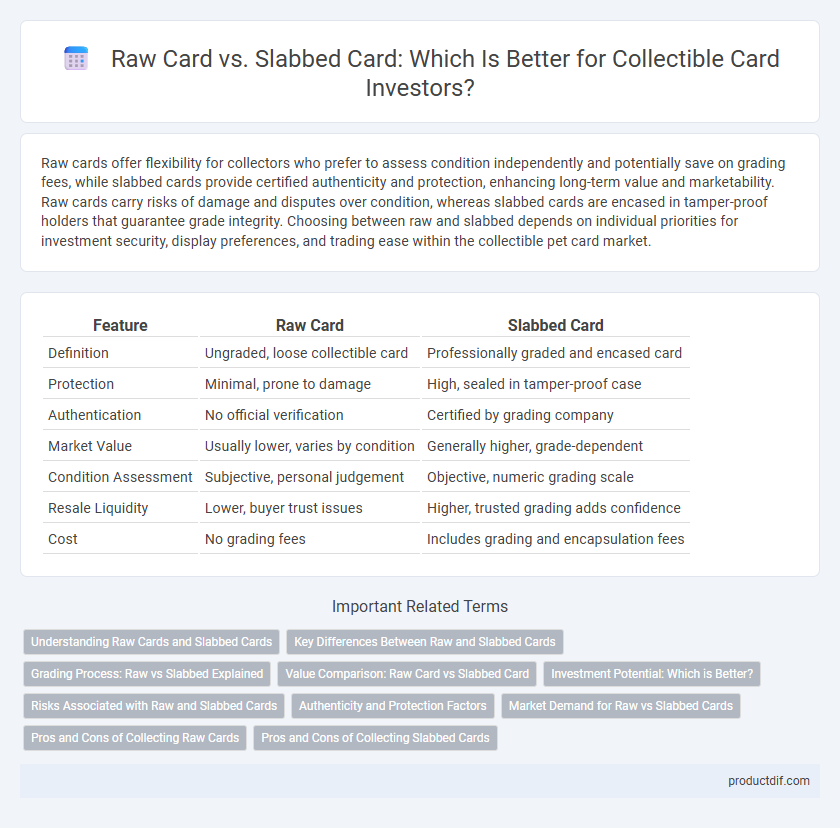Raw cards offer flexibility for collectors who prefer to assess condition independently and potentially save on grading fees, while slabbed cards provide certified authenticity and protection, enhancing long-term value and marketability. Raw cards carry risks of damage and disputes over condition, whereas slabbed cards are encased in tamper-proof holders that guarantee grade integrity. Choosing between raw and slabbed depends on individual priorities for investment security, display preferences, and trading ease within the collectible pet card market.
Table of Comparison
| Feature | Raw Card | Slabbed Card |
|---|---|---|
| Definition | Ungraded, loose collectible card | Professionally graded and encased card |
| Protection | Minimal, prone to damage | High, sealed in tamper-proof case |
| Authentication | No official verification | Certified by grading company |
| Market Value | Usually lower, varies by condition | Generally higher, grade-dependent |
| Condition Assessment | Subjective, personal judgement | Objective, numeric grading scale |
| Resale Liquidity | Lower, buyer trust issues | Higher, trusted grading adds confidence |
| Cost | No grading fees | Includes grading and encapsulation fees |
Understanding Raw Cards and Slabbed Cards
Raw cards refer to collectible trading cards that have not been professionally graded or encapsulated, allowing collectors to examine the card's condition firsthand but exposing it to potential damage. Slabbed cards are professionally graded, sealed within a tamper-evident plastic case, and assigned a condition score by an authorized grading company, providing authentication and protection. Understanding the difference between raw and slabbed cards is crucial for evaluating value, condition reliability, and long-term preservation in trading card collecting.
Key Differences Between Raw and Slabbed Cards
Raw cards lack professional grading and encapsulation, making them more vulnerable to damage and authenticity challenges. Slabbed cards are professionally graded, sealed in tamper-proof plastic cases, and assigned a numeric grade, ensuring protection and verified condition. The grading enhances market value and buyer confidence, distinguishing slabbed cards as premium collectibles compared to raw cards.
Grading Process: Raw vs Slabbed Explained
Raw cards are ungraded trading cards that collectors receive directly from packs or purchases, lacking any formal evaluation of condition or authenticity. Slabbed cards have undergone a professional grading process, where experts assess and authenticate the card's condition, assigning a numeric grade that is encapsulated in a tamper-evident protective case. This grading process enhances the card's market value by providing verified quality and protection against damage or alteration.
Value Comparison: Raw Card vs Slabbed Card
Raw cards often hold intrinsic value due to their unaltered condition, appealing to collectors seeking originality and potential for grading. Slabbed cards, encased in tamper-proof plastic with an official grade, typically command higher market prices by offering verified authenticity and condition assurance. Market trends show slabbed cards maintain or increase value faster, benefiting investors prioritizing liquidity and protection.
Investment Potential: Which is Better?
Raw cards often offer higher profit margins due to lower initial costs and the potential for future grading upgrades, making them attractive to investors seeking value growth. Slabbed cards provide immediate authenticity and condition assurance, reducing risk and appealing to collectors and investors prioritizing security and liquidity. Investment decisions depend on risk tolerance and market knowledge, with raw cards favoring speculative gains and slabbed cards offering stability.
Risks Associated with Raw and Slabbed Cards
Raw cards face risks such as physical damage, wear from handling, and potential authenticity issues due to lack of professional grading. Slabbed cards, while protected in tamper-proof cases, can still suffer from grading inconsistencies, high resale fees, and possible devaluation if grading scales change. Collectors must weigh the trade-offs between the vulnerability of raw cards and the secure, but sometimes costly and subjective, nature of slabbed card investments.
Authenticity and Protection Factors
Raw cards offer direct authenticity verification through the original issuer or seller, but they are vulnerable to wear and damage from handling or environmental exposure. Slabbed cards undergo professional grading and encapsulation, providing a tamper-evident seal that guarantees authenticity and significantly enhances protection against physical damage and counterfeiting. Collectors often prioritize slabbed cards for their certified condition and long-term preservation benefits, despite the higher initial investment.
Market Demand for Raw vs Slabbed Cards
Market demand for raw cards remains strong among collectors seeking affordability and flexibility in grading options, with many preferring to purchase raw cards and submit them for grading themselves. Slabbed cards, which are professionally graded and encapsulated, continue to attract premium buyers who prioritize authentication, condition assurance, and immediate market credibility. The market often shows higher prices for slabbed cards due to their verified quality, but raw cards maintain significant interest for investment potential and customization.
Pros and Cons of Collecting Raw Cards
Raw cards offer collectors direct access to the original condition of the card without third-party interference, preserving authentic wear and unique characteristics. These cards typically have lower acquisition costs and provide flexibility for grading decisions, allowing owners to choose their preferred grading service or keep them raw for personal display. However, raw cards carry higher risks of damage, forgery, and misidentification, which can affect long-term value and require careful handling and expert knowledge to authenticate.
Pros and Cons of Collecting Slabbed Cards
Slabbed cards offer enhanced protection with a hard plastic case that preserves condition and authenticity, often increasing resale value through professional grading. However, slabbed cards can be costly due to grading fees and lack the tactile experience of raw cards, making them less appealing for traditional collectors who prefer handling cards directly. Collectors gain market confidence and ease of storage from slabbed cards but sacrifice flexibility in trading and higher upfront investments.
Raw Card vs Slabbed Card Infographic

 productdif.com
productdif.com